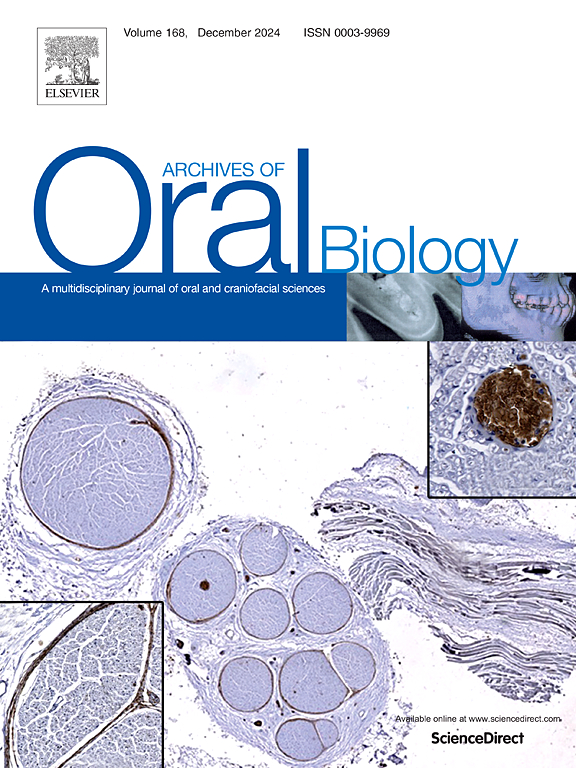学龄前双胞胎的牙釉质发育缺陷——巧合、遗传性和多水平分析
IF 2.1
4区 医学
Q2 DENTISTRY, ORAL SURGERY & MEDICINE
引用次数: 0
摘要
目的比较同卵双胞胎与异卵双胞胎牙釉质发育缺陷(DDE)的发生率,确定原牙列的遗传率,并探讨相关因素。设计对巴西特雷西纳3-5岁的学龄前双胞胎进行了横断面研究。不合作的儿童被排除在外。通过问卷调查和临床检查收集数据。临床评估是在学校环境中进行的,使用修改后的DDE指数进行诊断。使用四分频相关和多项逻辑回归分析巧合,得出比值比(OR)和95 %置信区间(95 %CI)。遗传率用Holzinger公式估计。多水平泊松回归发现与牙釉质发育缺陷发生相关的因素(p <; 0.05)。结果共纳入239对双胞胎,其中同卵96对,异卵143对。同卵的牙釉质发育缺陷相关性强/很强(总体DDE, 0.829;有界混浊,0.645;弥漫性混浊,0.812;发育不全,0.786),而异卵的牙釉质发育缺陷相关性弱/中等(总体DDE, 0.322;有界混浊,0.076;弥漫性混浊,0.562;发育不全,0.156)。与异卵双胞胎相比,同卵双胞胎的阳性(OR; 95 %CI = 2.04; 1.01-4.08)和阴性(OR; 95 %CI = 3.91; 1.47-10.36)的符合率更高。遗传率为74.8 %。子痫前期/子痫和出生第一年的高热与乳牙列中DDE的较高患病率相关。结论同卵双胞胎先天性牙釉质发育缺陷发生率高,遗传力高,提示先天性牙釉质发育缺陷的发生与遗传有关。子痫前期/子痫和出生第一年的高热是相关因素。本文章由计算机程序翻译,如有差异,请以英文原文为准。
Developmental defects of enamel in preschool twins – Coincidences, heritability, and multilevel analysis
Objective
To compare the coincidences of developmental defects of enamel (DDE) between monozygotic and dizygotic twins, determine heritability in primary dentition, and identify associated factors.
Design
A cross-sectional study was conducted among preschool twins aged 3–5 years in Teresina, Brazil. Non-cooperative children were excluded. Data were collected through questionnaires and clinical examinations. Clinical assessment was conducted in a school setting using the modified DDE Index for diagnostic purposes. Coincidences were analyzed using tetrachoric correlations and multinomial logistic regression, deriving Odds Ratios (OR) and 95 % confidence intervals (95 %CI). Heritability was estimated using Holzinger’s formula. Multilevel Poisson regression identified associated factors with developmental defects of enamel occurrence (p < 0.05).
Results
In total, 239 twin pairs were included (Monozygotic = 96, Dizygotic = 143). Correlations for developmental defects of enamel were strong/very strong in monozygotic (overall DDE, 0.829; demarcated opacities, 0.645; diffuse opacities, 0.812; hypoplasia, 0.786) and weak/moderate in dizygotic (overall DDE, 0.322; demarcated opacities, 0.076; diffuse opacities, 0.562; hypoplasia, 0.156). Monozygotic twins had more positive (OR; 95 %CI = 2.04; 1.01–4.08) and negative coincidences (OR; 95 %CI = 3.91; 1.47–10.36) than dizygotic twins did. Heritability was 74.8 %. Pre-eclampsia/eclampsia and high fever during the first year of life were associated with a higher prevalence of DDE in primary dentition.
Conclusions
Higher coincidences in monozygotic twins and high heritability suggest a genetic influence on the development of developmental defects of enamel in primary dentition. Pre-eclampsia/eclampsia and high fever in the first year of life were associated factors.
求助全文
通过发布文献求助,成功后即可免费获取论文全文。
去求助
来源期刊

Archives of oral biology
医学-牙科与口腔外科
CiteScore
5.10
自引率
3.30%
发文量
177
审稿时长
26 days
期刊介绍:
Archives of Oral Biology is an international journal which aims to publish papers of the highest scientific quality in the oral and craniofacial sciences. The journal is particularly interested in research which advances knowledge in the mechanisms of craniofacial development and disease, including:
Cell and molecular biology
Molecular genetics
Immunology
Pathogenesis
Cellular microbiology
Embryology
Syndromology
Forensic dentistry
 求助内容:
求助内容: 应助结果提醒方式:
应助结果提醒方式:


